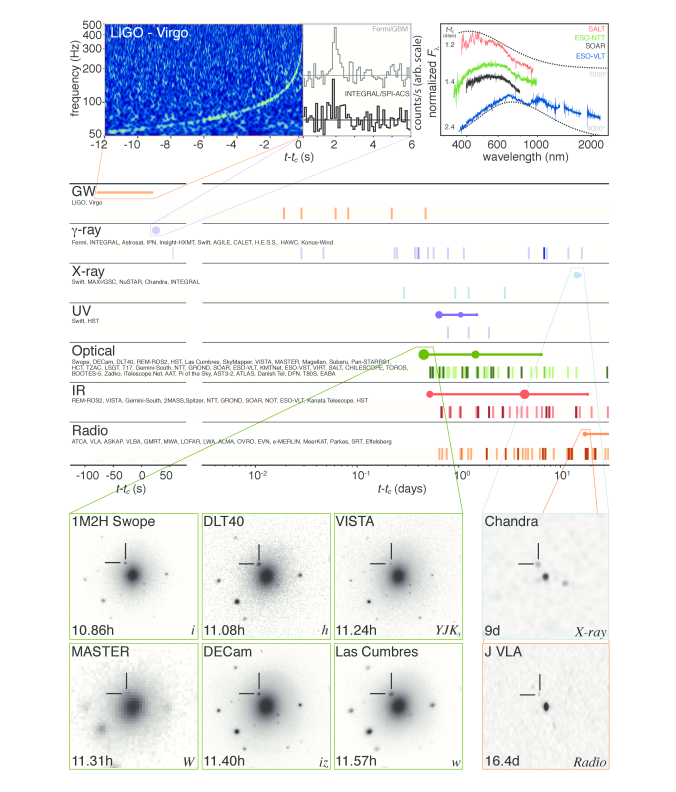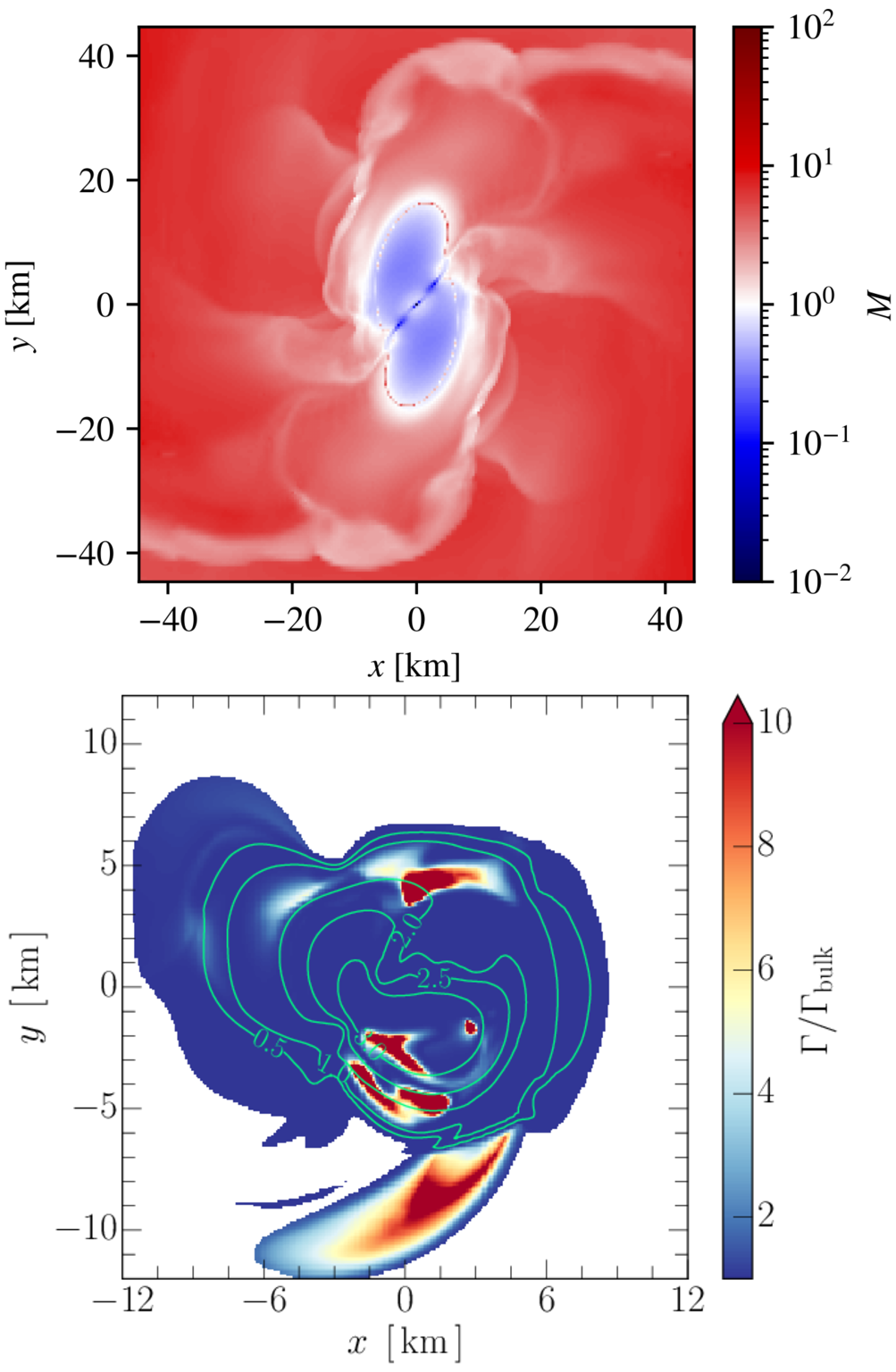Nuclear reactions, Bulk viscosity, Neutron Star mergers, and Gravitational Waves
- Ian Hawke
- P Hammond, T Celora, M Hatton
- J Foster
- N Andersson, G Comer
- See 2205.11377, 2108.08649, 2107.01083
- github.com/IanHawke
- STAG, University of Southampton
GW170817
-
One multimessenger detection.
- Gravitational waves;
- $\gamma$ - first detected;
- All EM band - long term.
- GWs seen for inspiral.
-
Constrains matter properties.
- Masses;
- Tidal compressibility;
- Equation of state.
- O4 just starting:
- Many more detections.
How does parameter estimation work?

Parameter Estimation
Neutron star merger
-
Merger is messy:
- Shearing instabilities;
- Temperature increase through shocks;
- Nuclear reactions.
- Urca reactions: $$ \begin{aligned} \text{n} &\to \text{p} + \text{e}^- + \bar{\nu}_e \\ \text{p} + \text{e}^- &\to \text{n} + \nu_e. \end{aligned} $$
- Keep track of species $Y_\text{e} \sim n_\text{e} / n_b$ by $$ D_t Y_\text{e} = \Gamma_\text{e}(n_b, T, Y_\text{e}). $$
- Urca timescale $\sim 10^{-8}-10^{-10}$ seconds: $< \Delta t$. Stiff: $\Gamma_\text{e} \gg 1$.
Toy model
Approximate fluid equations, using $\theta = \nabla_a u^a$:
$$ D_t \begin{pmatrix} n_b \\ e \\ Y_\text{e} \end{pmatrix} = - \begin{pmatrix} n_b \theta \\ \left( e + p(n_b, e, Y_\text{e}) \right) \theta \\ {\color{red}\epsilon^{-1}} \left( A Y_\text{e} - B \right) \end{pmatrix}. $$Short timescale encoded in $\epsilon \ll 1$.
Assume $Y_\text{e} = Y_0 + \epsilon Y_1 + \dots$ and separate scales:
$$ \begin{aligned} \mathcal{O}(\epsilon^{-1}) & \colon & 0 &= -A Y_0 + B & \implies & Y_0 = Y_\text{eq} = F(n_b, e), \\ \mathcal{O}(\epsilon^{0}) & \colon & D_t Y_0 &= -A Y_1 \\ & \implies & Y_1 &= -A^{-1} D_t Y_0 \\ & & &= G(n_b, e) \theta. \end{aligned} $$Expand pressure:
$$ \begin{aligned} p(n_b, e, Y_\text{e}) &= p(n_b, e, Y_\text{eq}(n_b, e)) + \epsilon \partial_{Y_\text{e}} p Y_1 \\ &= p_\text{eq}(n_b, e) + \Pi, \\ \Pi &= -\zeta(n_b, e) \theta. \end{aligned} $$Appearance of bulk viscous pressure.
Reduced model:
$$ D_t \begin{pmatrix} n_b \\ e \end{pmatrix} = - \begin{pmatrix} n_b \theta \\ (e + {\color{blue} p_\text{eq} + \Pi}) \theta \end{pmatrix}. $$- No longer tracking species: always in equilibrium.
- Scales now tractable: $\Gamma_\text{e} \sim \epsilon^{-1} \to \Pi \sim \epsilon.$
Impact of $\Pi$
Check with a "real" equation of state:
- Bulk viscous pressure can be big for neutron star core in merger;
- Bulk viscous approximation needed above dashed lines (resolution dependent).
Impact on GWs
- Do nonlinear merger simulation;
- Simulate with $\epsilon \to 0, \infty$;
- Filter out inspiral signal;
- Reactions "soften" EOS, $$\Delta f \simeq 58\textrm{Hz}$$
- Compute the mismatch between signals, $$ \mathcal{M} \sim 1 - \frac{\max \langle h_1 \vert h_2 (\sim \textrm{phase}) \rangle}{\sqrt{\langle h_1 \vert h_1 \rangle\langle h_2 \vert h_2 \rangle}} $$
- $$ \varrho_\textrm{req} \gtrsim 1 / \sqrt{2 \mathcal{M}} \quad = 1.2 $$ Limits are distinguishable in GWs by ET.
Solve the toy problem
- Full problem: $$ D_t \begin{pmatrix} n_b \\ e \\ Y_\text{e} \end{pmatrix} = - \begin{pmatrix} n_b \theta \\ (e + p) \theta \\ {\color{red}\epsilon^{-1}} \left( A Y_\text{e} - B \right) \end{pmatrix}. $$
- Bulk viscous approximation: $$ D_t \begin{pmatrix} n_b \\ e \end{pmatrix} = - \begin{pmatrix} n_b \theta \\ (e + {\color{blue} p_\text{eq} + \Pi}) \theta \end{pmatrix}. $$
- "Infinitely fast" $\implies \Pi \to 0$.
- ${\footnotesize \zeta = \epsilon p_{,Y_\text{e}} A^{-1} \left( n_b Y_{\text{eq},n_b} + (e + p_\text{eq}) Y_{\text{eq}, e} \right) }.$
Check accuracy
- Vary the fast timescale.
-
See the expected behaviour:
- Leading order error $\propto \epsilon$;
- Bulk viscous error $\propto \epsilon^2$;
- More terms including, better overall error.
Argues for the use of the bulk viscous pressure correction.
Start out-of-equilibrium
- Previously $$ Y_\text{e}(t=0) = Y_\text{eq}(t=0), $$ equilibrium.
- Now set $$ \begin{aligned} \Delta Y &= Y_\text{e}(t=0) - Y_\text{eq}(t=0) \\&= \mathcal{O}(1). \end{aligned} $$
- $Y_\text{e} \to Y_\text{eq}$ exponentially, timescale $\epsilon^{-1}$.
- $\Pi$ correction doesn't seem as accurate.
Check accuracy
- Vary the fast timescale.
-
Do not see the expected behaviour:
- Leading order error $\propto \epsilon$;
- Bulk viscous error $\propto \epsilon$!
- Errors comparable.
What has gone wrong?
- Did power series expansion $$ Y_\text{e} = Y_0 + \epsilon Y_1 + \dots $$
- Cannot capture boundary layer - exponential term.
Boundary layers
- Solution: rescale $\tau = t / \epsilon$.
- Re-solve using $$ Y_\text{e} = \tilde{Y}_0(\tau) + \epsilon \tilde{Y}_1(\tau) + \dots $$
- Captures exponential behaviour in $t$.
- Matched asymptotics: $$ \tilde{e}(\tau=1) = e(t = \epsilon). $$
- $\epsilon \ll 1$, match "changes initial data".
- Simple fix: $$ e(t=0) \to e(0) - \epsilon A^{-1} \Delta Y p_{,Y_\text{e}} \theta. $$
Check accuracy
- Vary the fast timescale.
-
Again see the expected behaviour:
- Leading order error $\propto \epsilon$;
- Bulk viscous error $\propto \epsilon^2$
Matched asymptotics and modifying the initial data mean we can successfully use bulk viscous approximations.
Within a numerical scheme, discrete steps or multi-physics aspects can act to push things out of equilibrium...
Summary
- Neutron star mergers need nonlinear numerical simulations.
- Timescales mean subgrid schemes/models required.
- Interpret models as bulk viscous corrections.
- Modelling reactions necessary to avoid systematic errors.
Look out for problems!
- Coupling to full radiation hydro might give double counting issues.
- Potential for boundary layer issues in numerical codes.
